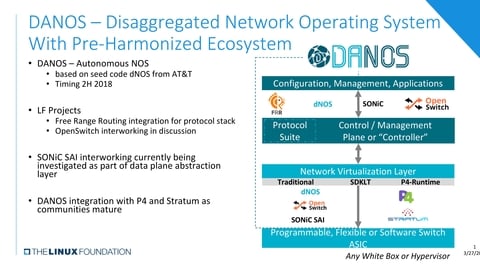LOS ANGELES – The Linux Foundation has introduced the Disaggregated Network Operating System (DANOS) project to enable what it says will be community collaboration across network hardware, forwarding, and operating system layers.
DANOS builds off AT&T’s Open Architecture for a Disaggregated Network Operating System (dNOS) concept. dNOS separates the operation of the router’s “Network Operating System” software from its underlying hardware (router chassis, routing controller and forwarding line-cards).
Already, AT&T is applying concepts to its own services. Business customers that purchase AT&T’s FlexWare service will get a fully functional router that can support various services, including SD-WAN and security. FlexWare, which is AT&T’s Universal CPE (uCPE) platform, allows businesses to set up multiple virtual network functions, such as a router and a firewall, on a single FlexWare device, for example.
The Linux Foundation will incorporate contributions from complementary open source communities to build a standardized distributed Network Operating System (NOS).
Up till now NOS creation has been challenging due to the complexity and magnitude of software and hardware requirements. This is because each device in the network needs its own operating system.
Arpit Joshipura, general manager of networking for the Linux Foundation, said that it has put in place the necessary foundation to drive DANOS forward. DANOS integration with P4 and Stratum will emerge as the communities mature.

“We have put together the pre-harmonized ecosystem where we’ll take DANOS—which is based on seed code from AT&T’s dNOS—and the 2 LF projects Open Stack and Open Switch to figure out the best harmonized way of doing things,” Joshipura said.
Joshipura added that the collaboration between the various open source groups reflects the goal it set out with creating LFN.
“This is the power of LF to bring multiple projects together,” Joshipura said. “Rather than wait for five different ways to do it, we align as much as possible at the lower layers and the operating systems can continue to solve unique problems.”
However, the growth of open source combined with advances in both software and hardware, has fostered an ecosystem of advanced networking applications, new and open technologies, and building blocks on which to host an open and flexible NOS.
Linux Foundation members are currently developing code and collateral transitions as the community begins to coalesce around the DANOS framework. The organization expects to have its first code release is expected the second half of 2018.

DANOS has gotten support from various Linux Foundation groups and members including Broadcom, Inocybe, Metaswitch, and Silicom.
DANOS also calls for standard Application Programming Interfaces that provide a framework within the base operating system, data planes and control and management plane. Using any white box of hypervisor, DANOS includes five operating systems (OS): Free Range Routing (FRR), SONiC SAI, Open Switch, Stratum and P4.
